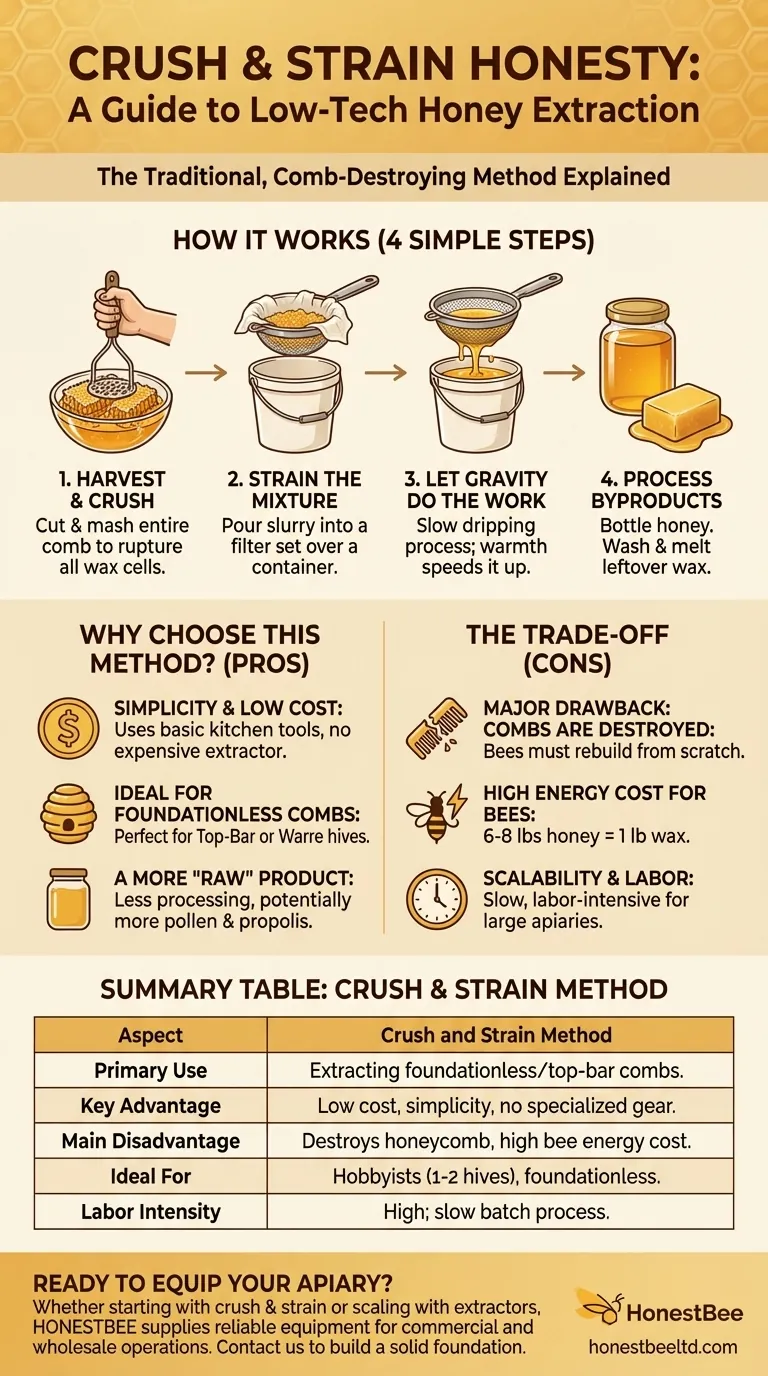To put it simply, the crush and strain method is a traditional, low-tech way to separate honey from its honeycomb. It involves physically mashing the entire comb and then pouring the mixture through a filter or mesh, allowing gravity to separate the liquid honey from the solid pieces of beeswax. This approach is fundamentally different from centrifugal extraction, which preserves the comb.
This method is defined by its simplicity and accessibility, making it ideal for new beekeepers or those with foundationless hives. However, its primary trade-off is the complete destruction of the honeycomb, which forces the bees to expend significant energy rebuilding it.

How the Crush and Strain Method Works
The process is straightforward and relies on basic kitchen equipment rather than specialized machinery. It breaks down into a few simple stages.
The Core Principle: Destroy to Extract
Unlike methods that use centrifugal force to sling honey out of the cells, crush and strain works by breaking open the wax cells entirely. This releases all the contained honey at once.
Step 1: Harvest and Crush the Comb
First, the beekeeper cuts the honeycomb from the frame or top bar. The comb is then placed into a food-grade bucket or bowl and mashed with a clean tool, such as a potato masher, or even by hand. The goal is to rupture every wax cell.
Step 2: Strain the Mixture
The resulting slurry of honey and wax is poured into a sieve or colander lined with a filter, like cheesecloth or a fine mesh screen. This setup is placed over a clean container.
Step 3: Let Gravity Do the Work
The honey slowly drips through the filter into the collection container below. This process can take several hours or even overnight. Keeping the setup in a warm room will lower the honey's viscosity and speed up the draining process.
Step 4: Process the Byproducts
Once drained, the pure honey is ready for bottling. The leftover beeswax, still mixed with some residual honey, can be washed and melted down for use in candles, balms, or other projects.
Why Choose This Method?
While modern extractors are highly efficient, the crush and strain method remains popular for several key reasons, particularly among hobbyist beekeepers.
Simplicity and Low Cost
This is the most significant advantage. It requires no expensive extractor, uncapping knives, or other specialized gear. Most of the necessary tools—buckets, colanders, and filters—are already in a typical kitchen.
Ideal for Foundationless Combs
The crush and strain method is perfectly suited for combs that are not built on a plastic or wired foundation. This includes combs from top-bar hives, Warre hives, or any foundationless frames, which cannot withstand the force of a centrifugal extractor.
A More "Raw" Product
Because it involves less processing and filtering can be adjusted, this method often leaves more pollen and propolis in the final product. Many believe this results in a honey with a more robust flavor and potentially higher nutritional value.
Understanding the Trade-offs
The simplicity of the crush and strain method comes with a significant cost that every beekeeper must consider carefully.
The Major Drawback: Destroying the Comb
The primary disadvantage is that the honeycomb is completely destroyed. Bees expend an enormous amount of energy and resources to produce wax and draw it into a perfect hexagonal comb.
The Impact on Your Bees
It is estimated that bees consume 6-8 pounds of honey to produce just one pound of wax. By destroying the comb, you force the colony to restart this energy-intensive process from scratch, which can reduce the amount of surplus honey they produce next season.
Scalability and Labor
While simple, the crush and strain method is slow and labor-intensive. It is not practical for beekeepers managing more than a few hives, as the process of crushing and draining small batches takes a significant amount of time. In contrast, a centrifugal extractor can process many frames quickly.
Making the Right Choice for Your Apiary
Your choice of extraction method depends entirely on your beekeeping philosophy, hive type, and scale.
- If your primary focus is simplicity and low startup cost: Crush and strain is the ideal method, especially if you have only one or two hives.
- If you use top-bar hives or foundationless frames: Crush and strain is your only viable option, as these combs cannot be put through an extractor.
- If your primary focus is maximizing honey production and minimizing stress on your bees: Investing in a centrifugal extractor is the better long-term strategy, as it preserves the invaluable drawn comb.
Ultimately, understanding the energy cost to your bees is the key to deciding which path is right for you and your hives.
Summary Table:
| Aspect | Crush and Strain Method |
|---|---|
| Primary Use | Extracting honey from foundationless or top-bar hive combs |
| Key Advantage | Low cost and simplicity; no specialized equipment needed |
| Main Disadvantage | Destroys the honeycomb, forcing bees to rebuild it |
| Ideal For | Hobbyist beekeepers with 1-2 hives or foundationless frames |
| Labor Intensity | High; slow, batch-by-batch process |
Ready to equip your apiary for success? Whether you're a hobbyist starting with the crush and strain method or a commercial beekeeper scaling up with centrifugal extractors, HONESTBEE has the reliable supplies you need. We supply high-quality beekeeping equipment and supplies through wholesale-focused operations to commercial apiaries and distributors. Contact our team today to discuss your needs and ensure your beekeeping operation is built on a solid foundation.
Visual Guide

Related Products
- Stainless Steel Manual Honey Press with Guard for Pressing Honey and Wax
- Stainless Steel Honey Press Wax Press with Tank
- 10L Stainless Steel Electric Honey Press Machine
- Professional Wide Blade Honey Scraper for Beekeeping and Honey Processing
- Electric Flatting and Embossing Machine with Tray for Beekeeping
People Also Ask
- What are the multipurpose functionalities of a honey press? Versatile Harvesting for Beekeepers & Homesteaders
- What happens to the wax after pressing in a honey press? A Guide to Maximizing Your Hive's Yield
- How can a honey press be used beyond honey extraction? Unlock Its Full Potential for Your Farm
- What was the overall experience with the honey press? Maximize Yield for Small-Scale Beekeeping
- What are the benefits of the screw design in a stainless steel honey pump? Preserve Honey Quality and Integrity



















